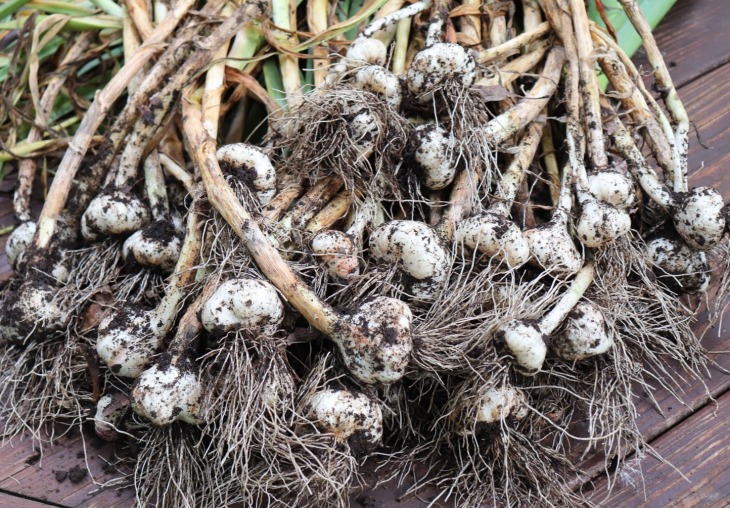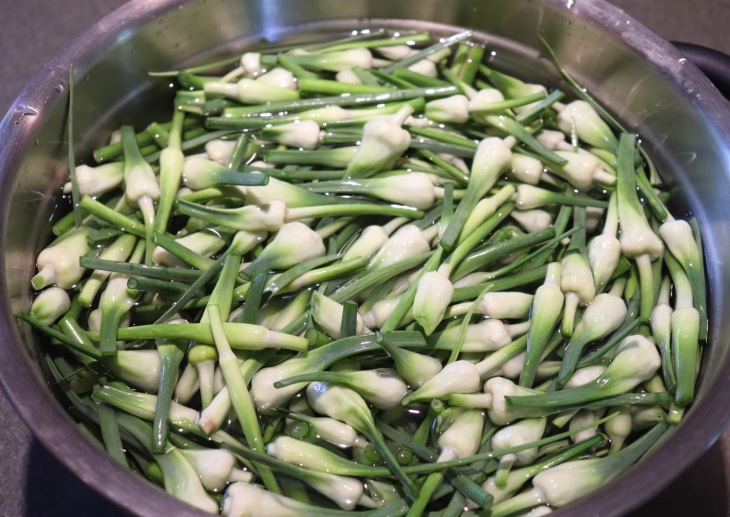
You may have gotten an inkling that we like our garlic here. We might even be called garlic fanatics. While traveling, I sometimes choose a restaurant based on the smell of garlic coming from its vents. Menu selections are settled when a dish is described as being loaded with garlic. A shared love of garlic, I believe, is a key factor in choosing a spouse.
One of the best ways to get some really great garlic is to grow it yourself. By growing your own garlic, you may choose an array of flavors and heat levels you will rarely get from a grocery store or farmer’s market, where quality may be good, but choices of varieties are usually somewhat limited.
I usually plant enough garlic to get about 50 pounds of harvest. This is a bit over one head per day. Still, come late winter I find myself needing to buy garlic. Yeah, I use a decent amount of garlic in my cooking.

I order seed garlic from Keene Organics or Filaree Garlic Farm. I place my order in July around the time I am harvesting my own garlic. Ordering early is key to getting the varieties you want. If the choices overwhelm you, the farms will recommend varieties to suit your conditions. The farms will sell out of the best varieties early, and ordering early gets you the choice selection of the largest bulbs for planting. I have the garlic shipped to me in September or October, just in time to plant. Planting must be done before a freeze to allow the cloves to start to grow. By late November, I can see that the garlic patch is well underway.
Then in Spring, the garlic grows like crazy. Before you get down into the specific varieties of garlic, or even the sub-types (silverskin, artichoke, rocambole, Asiatic, purple stripe, porcelain, etc.), there are two main categories of garlic: hardneck and softneck. Hardneck types have a woody stalk in the middle of each head of garlic with the cloves surrounding that stalk. The stalk is the bottom end of a flower that the plant sends up in Spring.
That stalk, also known as the scape, is the topic of this post. When hardneck garlic sends up this flower stalk, it is curved, or even coiled in some cases. If left in place, the stalk will become woody and will straighten up. The top of the stalk will form a flower or a miniature head of garlic bulblets. You may let your garlic develop like this, and you can plant the bulblets or roast them inside a chicken with some herbs and cured lemons, but the issue with this is that the plant is then directing its energy into the flower and not into production of the best bulb underground. For this reason, the flowering stalks should be clipped off above the top leaf before they start to straighten.
Softneck garlic harvest starts soon after the hardnecks produce their scapes. Hardnecks are dug in the weeks following the scape production.

My garlic patch produces between 300-400 scapes in a normal growing season. This bounty of garlicky goodness finds many uses in the kitchen. I have charred them a bit and used as a pizza topping, and I have used scapes to make some nice kimchi (they are great for fermented items like kimchi, in fact.) If you’re cont growing garlic, look for scapes in the markets in June.

Here are a few more ideas to make sure no scape escapes. I start by rinsing my harvest of scapes with cold tap water. Next, I make a light mark on my cutting board to 3-7/8″ which is the perfect size for the wide mouth pint jars I used for canning small pickled items. Remove any woody ends of the scapes and discard. Also discard any discolored or malformed pieces. The straightest pieces of scape (stalk and flower) go into a large bowl of cool water. Curved pieces go into a separate pile.

Pickled Garlic Scapes
I like to make a variety of pickles to accompany trays of homemade charcuterie, and this is a good one for that. My canning kettle holds seven jars, so that is my normal batch size. When processing scapes into food products, I will make these pickles first to use the choicest straight pieces.
Garlic scapes cut in 3-7/8″ sections, tender stalks and flower tops
750ml homemade apple cider vinegar (may use commercial vinegar)
750ml water
75g sea salt
7t dill seed
3-1/2T wild black pepper (may use your preference of black pepper)
Fill canner to just below suspended rack with hot water, and place on stove to boil. Clean the jars, rings and lids. Place the rings and lids in a small pot of water to simmer. Place the vinegar, water and salt in another pot and heat to a simmer. Place 1t dill seed and 1/2t peppercorns in each jar. Tightly pack scapes in the jars. Bring the vinegar mixture to a boil and pour some into each jar to cover the packed scapes. Seal with lids and rings. Place the jars into the canner rack while the water in the canner comes to a boil. This will reduce the risk of thermal shock to the jars when they are lowered into the boiling water. When the canner comes to a boil, lower the rack to completely submerge the jars (add more water if needed). Remove the jars after 10 minutes and allow them to cool, untouched. Check the seals when the jars are cooled. Place any unsealed jars in the fridge to use first. Mark the sealed jars with a date, remove the rings and store in the pantry. Wait a month before using the pickles.

From the scapes that are left over at this point, you can pick out some to add to stir fries, use as pizza toppings, etc. Store in the crisper of your fridge. The rest go into the food processor and get minced for these next two items.
Scape Pesto
2 cups minced scapes
1/2 cup almonds toasted in a dry skillet
1 preserved lemon, seeds removed
4 sprigs fresh basil (discard stems)
3/4 cup finely grated Parmigiano-Reggiano
Olive oil (the best you can afford)
Salt and pepper to taste
Place the first five items in the food processor and pulse to finely chop and mix them up. With the food processor running, add olive oil to get the consistency you desire. Add salt and pepper, pulse a few more times, and taste. Adjust as needed.
Pesto freezes very well. Freeze in a bag or container that allows you to cut off what you need when you use it. This pesto if great on pasta, fish, chicken, or even on a piece of great bread!

Garlic Scape and Herb Compound Butter
1/2 lb unsalted butter
1/4 cup olive oil
1 cup minced scapes
2T fresh oregano leaves
1T fresh thyme leaves
Place everything in the bowl of a food processor and pulse until all is evenly mixed. Place in a jar and store in the fridge. Pretty simple!
Put a pat of this on a grilled steak. Brush onto grilled wild salmon. And let’s not forget corn on the cob is coming up soon! (not soon enough).

